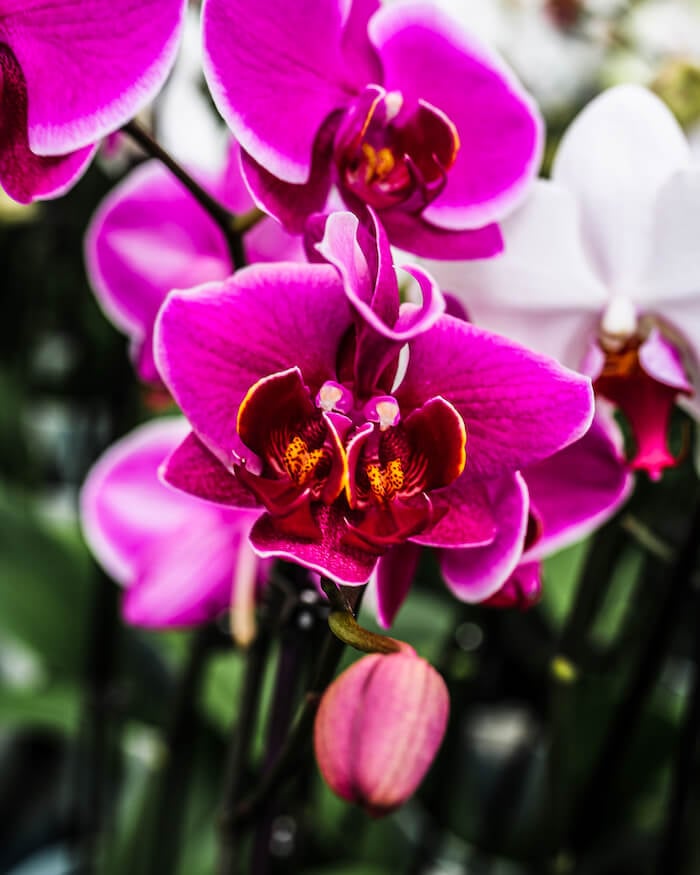
What is the life cycle of growing orchids? What are some orchid growth habits? It's more complicated than you might think.
Did you know that when you buy a Just Add Ice® orchid at your favorite retail store, it took about two years to grow into the beauty it is now?
Our orchids are so easy to care for that you also may not realize all the work that goes into growing them. Our growers do all that work for you so that by the time you take your orchid home, all you have to do is remember to water it once a week with ice cubes or water.
If you’ve always wondered where your orchids come from and how they grow, here’s a glimpse into the secret lives of orchids in our greenhouse.
Understanding the growth habits of orchids extends beyond their physical appearance; it delves into their life cycle. When you bring home a Just Add Ice® orchid, you're welcoming a botanical marvel that took years of work!
Is Your Orchid Epiphytic or Terrestrial?
One of the first things you should know about orchids is that most orchids being cultivated, including Phalaenopsis orchids, are epiphytes. Epiphyte is a Greek term meaning “grow on a plant” or “air plant." Unlike a terrestrial plant, which grows on the ground, an epiphyte grows on a tree or rock, and its roots are exposed to the air instead of buried underground. However, it is not a parasite; it merely perches on another plant to get its nutrients and moisture from rain, air and debris.

Although we grow orchids locally, most of our Phalaenopsis orchids originally come from Europe or Asia. They start out as tissue cultures, which are the results of a crossing between two different parent varieties. These crossings are made by a breeder.
Once we receive the tissue culture, we hand place each one into soil, separated by size and numerous other factors.
It takes two years for each to germinate and develop into a unique individual flowering plant. Our growers examine these individual plants for several factors, including color, size and height compared to our expected growth, as well as number of leaves and blooms within the time frame.
This part of the orchid life cycle takes a long time, but it’s worth the wait!

Once the orchid tissue cultured plant has developed enough, it 'graduates' to our greenhouse. It receives plenty of light, and we continually adjust the temperature and humidity as it grows. The orchid goes through two cycles of growing and repotting before it’s ready to bloom. The greenhouse includes our state-of-the-art grading system to determine orchid quality, the only one of its kind in North America.
Also, all the water used in the growing process is 100% recycled and reused. With drought concerns facing growers worldwide, rainwater has become a vital irrigation source. Our retention ponds collect 1.5 million gallons of fresh water for every one inch of rainfall received.

At this point, the orchid has been growing for one year, but it still needs several more months to develop. As it grows, we’ll continue to monitor its progress, evaluating its growth and plant health. The health of the leaves is a major factor to consider with an orchid, before and after blooming.
This is why even once you take your orchid home, we tell you to use the leaves as a great indicator of your plant’s health.
We use advanced scanning technology to ensure each plant reaches its growth milestones before graduating to another section of the greenhouse. If it doesn’t measure up, it doesn’t move on.

This is our favorite part! After seeing only roots and leaves for so long, our growers are always excited to see the first bloom.
To trigger orchid blooming, we move the orchid from a warm section of the greenhouse to another area that’s cooler. The orchid will get its 'baby spikes' first.
Then, after about 15 weeks of growth, that magic moment happens.

We want to make sure all our growing orchids have a consistent size, appearance, quality and health no matter where you buy them. That’s why we put our orchids through a series of trials during their growth. That includes testing the pH levels of the soil, evaluating different potting media and examining color consistency.

Once the orchid is mature, it’s moved to a staging area where it will live for four weeks before traveling to a retail store near you. After it has found a new home, you can expect it to stay in bloom for up to three months before going into a nine-month resting period.
And by following a few easy steps, you can coax it to rebloom again!
Explore our variety of colorful options as a perfect addition to any interior space. To learn more about growing orchids and how to care for your Phalaenopsis orchid, check out our complete guide to orchid care.
How Long Do Orchids Live?
Once you bring your plant home, you can keep an orchid for YEARS. Truly, once the initial blooms fall off, consistent care will encourage your orchid to rebloom. You will need to perform routine maintenance over time, like trimming stems, leaves and even air roots.
However, as long as you take care of your plant, you can enjoy it for a long time!

Copyright Just Add Ice® Orchids 2023